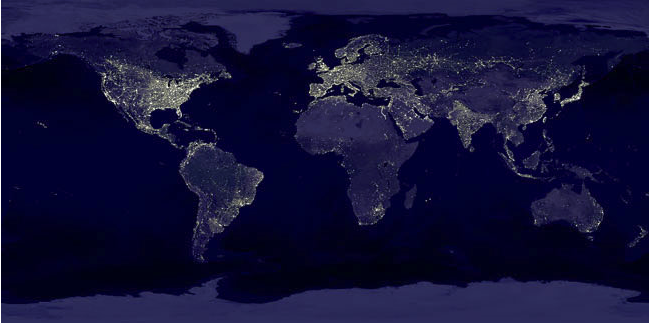
400 years ago the Italian astronomer Galileo Galilei wrote, “If you could see the earth illuminated when you were in a place as dark as night, it would look to you more splendid than the moon.” Clearly, a man ahead of his time.
I was seven when John Glenn first shot into space. It was an extraordinary event that we watched from a somewhat snowy black-and-white TV. Fast-forward seven years and the first images of planet earth, as viewed from space, made a somehow different, and perhaps longer-lasting impression. Thank you (South 40’s) Stewart Brand for prying those images from NASA’s hands. Seeing the Whole Earth has stayed with me as a pivotal moment. The year was 1968.
Nearly one-half century later, we’ve come to take for granted the view of earth from outer space. And gradually we’ve also grown accustomed to seeing less and less of the wonder that is the great expanse above us. Light pollution, here loosely defined as wasted light, is light that spills over beyond where it’s needed, or lights left on when not needed at all. As much as any other pollutant, photons wreak havoc upon our own health and the welfare of myriad species: birds, coral, turtles and zooplankton alike. That there exist terms such as light trespass and skyglow should give us pause for thought. Over-illumination says it all.
We’ve just come to the end of International Dark-Sky Week—the week surrounding the new moon in April—when the sky is at its darkest. It’s a fairly recent phenomenon—started by high school student Jennifer Barlow in 2003—but the event has gained international traction. It’s not just astronomers; people the world over are turning off their lights (to varying degrees) for the week. Can we see the impact of each of those small gestures? Perhaps not, but we can use this time to reflect upon small changes we can make.
Terri Thomas and I have talked about tackling light pollution within the floating homes community—a topic we discussed last year as a possible focus of the FHA Environmental Committee. It’s within our capabilities, as a community, to take measures to mitigate the light spilling beyond where it’s needed, as well as washing out the sky. The new downward-directed lighting in the WPH parking lots is a move in the right direction. Here we are living in a dynamic environment, filled each day with changing tides, birds, fishes and skies. And yet we’re missing one of the greatest pleasures of all: the nighttime sky, in all its glory.
Follow these links to two articles, the first a NY Times piece that caught my eye: Nicholas St. Fleur’s Illuminating the Effects of Light Pollution. And the second Terri’s own riff on the pleasure she takes in the night sky, written in conjunction with her role as Director of Conservation, Stewardship and Research at The Presidio Trust, on the occasion of some recent Presidio Stargazing parties.
The next Presidio Stargazing Party is on Thursday, April 14, 2016.